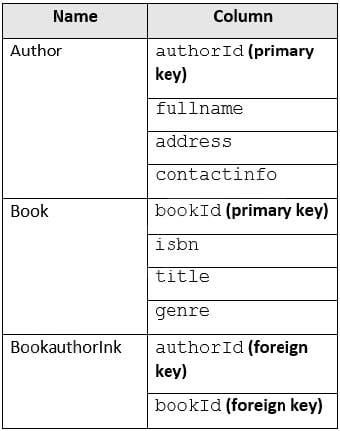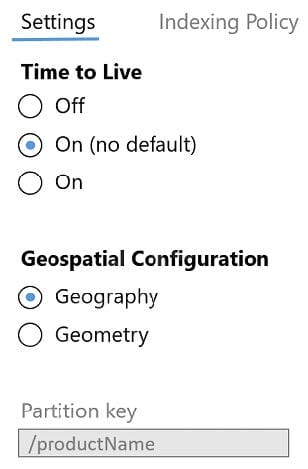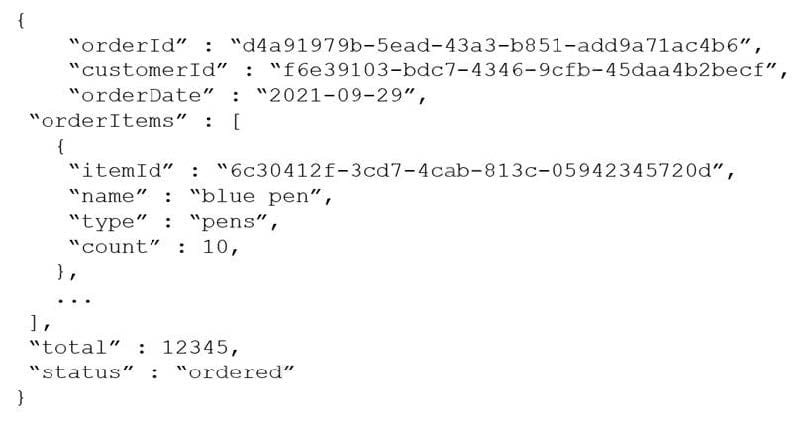Exam Details
Exam Code
:DP-420Exam Name
:Designing and Implementing Cloud-Native Applications Using Microsoft Azure Cosmos DBCertification
:Microsoft CertificationsVendor
:MicrosoftTotal Questions
:158 Q&AsLast Updated
:Jun 10, 2025
Microsoft Microsoft Certifications DP-420 Questions & Answers
-
Question 11:
You have a container in an Azure Cosmos DB Core (SQL) API account. The container stores telemetry data from IoT devices. The container uses telemetryId as the partition key and has a throughput of 1,000 request units per second (RU/s).
Approximately 5,000 IoT devices submit data every five minutes by using the same telemetryId value.
You have an application that performs analytics on the data and frequently reads telemetry data for a single IoT device to perform trend analysis.
The following is a sample of a document in the container.

You need to reduce the amount of request units (RUs) consumed by the analytics application. What should you do?
A. Decrease the offerThroughputvalue for the container.
B. Increase the offerThroughputvalue for the container.
C. Move the data to a new container that has a partition key of deviceId.
D. Move the data to a new container that uses a partition key of date.
-
Question 12:
You maintain a relational database for a book publisher. The database contains the following tables.

The most common query lists the books for a given authorId.
You need to develop a non-relational data model for Azure Cosmos DB Core (SQL) API that will replace the relational database. The solution must minimize latency and read operation costs.
What should you include in the solution?
A. Create a container for Author and a container for Book. In each Author document, embed bookId for each book by the author. In each Book document embed authorIdof each author.
B. Create Author, Book, and Bookauthorlnk documents in the same container.
C. Create a container that contains a document for each Author and a document for each Book. In each Book document, embed authorId.
D. Create a container for Author and a container for Book. In each Author document and Book document embed the data from Bookauthorlnk.
-
Question 13:
The settings for a container in an Azure Cosmos DB Core (SQL) API account are configured as shown in the following exhibit.

Which statement describes the configuration of the container?
A. All items will be deleted after one year.
B. Items stored in the collection will be retained always, regardless of the items time to live value.
C. Items stored in the collection will expire only if the item has a time to live value.
D. All items will be deleted after one hour.
-
Question 14:
After you answer a question in this section, you will NOT be able to return to it. As a result, these questions will not appear in the review screen.
You have an Azure Cosmos DB Core (SQL) API account named account 1 that uses autoscale throughput.
You need to run an Azure function when the normalized request units per second for a container in account1 exceeds a specific value.
Solution: You configure the function to have an Azure CosmosDB trigger.
Does this meet the goal?
A. Yes
B. No
-
Question 15:
After you answer a question in this section, you will NOT be able to return to it. As a result, these questions will not appear in the review screen.
You have a container named container1 in an Azure Cosmos DB Core (SQL) API account.
You need to make the contents of container1 available as reference data for an Azure Stream Analytics job.
Solution: You create an Azure function that uses Azure Cosmos DB Core (SQL) API change feed as a trigger and Azure event hub as the output.
Does this meet the goal?
A. Yes
B. No
-
Question 16:
After you answer a question in this section, you will NOT be able to return to it. As a result, these questions will not appear in the review screen.
You have a container named container1 in an Azure Cosmos DB Core (SQL) API account.
You need to make the contents of container1 available as reference data for an Azure Stream Analytics job.
Solution: You create an Azure Data Factory pipeline that uses Azure Cosmos DB Core (SQL) API as the input and Azure Blob Storage as the output.
Does this meet the goal?
A. Yes
B. No
-
Question 17:
After you answer a question in this section, you will NOT be able to return to it. As a result, these questions will not appear in the review screen.
You have a container named container1 in an Azure Cosmos DB Core (SQL) API account.
You need to make the contents of container1 available as reference data for an Azure Stream Analytics job.
Solution: You create an Azure Synapse pipeline that uses Azure Cosmos DB Core (SQL) API as the input and Azure Blob Storage as the output.
Does this meet the goal?
A. Yes
B. No
-
Question 18:
You need to implement a trigger in Azure Cosmos DB Core (SQL) API that will run before an item is inserted into a container. Which two actions should you perform to ensure that the trigger runs? Each correct answer presents part of the solution. NOTE: Each correct selection is worth one point.
A. Append pre to the name of the JavaScript function trigger.
B. For each create request, set the access condition in RequestOptions.
C. Register the trigger as a pre-trigger.
D. For each create request, set the consistency level to session in RequestOptions.
E. For each create request, set the trigger name in RequestOptions.
-
Question 19:
You have an Azure Cosmos DB Core (SQL) API account.
You run the following query against a container in the account.
SELECT
IS_NUMBER("1234") AS A,
IS_NUMBER(1234) AS B,
IS_NUMBER({prop: 1234}) AS C
What is the output of the query?
A. [{"A": false, "B": true, "C": false}]
B. [{"A": true, "B": false, "C": true}]
C. [{"A": true, "B": true, "C": false}]
D. [{"A": true, "B": true, "C": true}]
-
Question 20:
The following is a sample of a document in orders.

The orders container uses customerIdas the partition key.
You need to provide a report of the total items ordered per month by item type. The solution must meet the following requirements:
1.
Ensure that the report can run as quickly as possible.
2.
Minimize the consumption of request units (RUs). What should you do?
A. Configure the report to query orders by using a SQL query.
B. Configure the report to query a new aggregate container. Populate the aggregates by using the change feed.
C. Configure the report to query orders by using a SQL query through a dedicated gateway.
D. Configure the report to query a new aggregate container. Populate the aggregates by using SQL queries that run daily.
Related Exams:
62-193
Technology Literacy for Educators70-243
Administering and Deploying System Center 2012 Configuration Manager70-355
Universal Windows Platform – App Data, Services, and Coding Patterns77-420
Excel 201377-427
Excel 2013 Expert Part One77-725
Word 2016 Core Document Creation, Collaboration and Communication77-726
Word 2016 Expert Creating Documents for Effective Communication77-727
Excel 2016 Core Data Analysis, Manipulation, and Presentation77-728
Excel 2016 Expert: Interpreting Data for Insights77-731
Outlook 2016 Core Communication, Collaboration and Email Skills
Tips on How to Prepare for the Exams
Nowadays, the certification exams become more and more important and required by more and more enterprises when applying for a job. But how to prepare for the exam effectively? How to prepare for the exam in a short time with less efforts? How to get a ideal result and how to find the most reliable resources? Here on Vcedump.com, you will find all the answers. Vcedump.com provide not only Microsoft exam questions, answers and explanations but also complete assistance on your exam preparation and certification application. If you are confused on your DP-420 exam preparations and Microsoft certification application, do not hesitate to visit our Vcedump.com to find your solutions here.